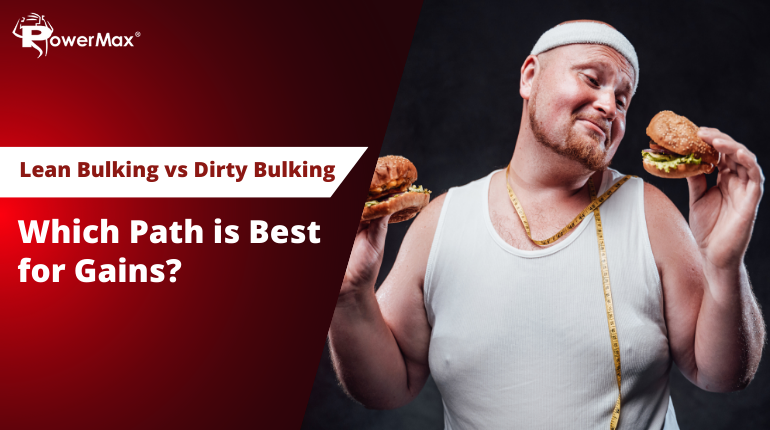Introduction
Your choice of path can have a big impact on your general health and muscle growth results. The two most common approaches are dirty bulking and lean bulking. Every strategy has supporters, advantages, and disadvantages. This article will go into great detail about both tactics to assist you in choosing wisely as you proceed toward success.
What is Bulking?
During the bulking phase of bodybuilding and fitness, gaining weight, especially muscular mass, is the main objective. During this period, you typically consume a caloric surplus, or more food than you burn, in order to supply the energy and minerals required for muscle building.
Lean Bulking Explained:
Lean bulking is the process of building muscle while accumulating the least amount of fat possible. It highlights eating a clean diet full of foods high in nutrients.
Key Features:
Caloric Surplus:
A minor caloric surplus of approximately 250–500 calories above maintenance levels is typically associated with a lean bulk.
Nutrient Quality:
Complex carbs, healthy fats, and high-quality proteins are prioritized. Consider fruits, veggies, whole grains, and lean meats.
Consistent Monitoring:
Regular monitoring is necessary to guarantee that the bulk stays lean. This includes keeping track of changes in strength and body composition. Focus on Protein For muscle growth and repair, an increased protein intake of 1.6–2.2 grams per kilogram of body weight is essential.
Exercise Program:
To optimize muscular growth, a systematic weightlifting program is essential. This program should involve progressive overload.
Pros of Lean Bulking:
Minimized Fat Gain:
It is simpler to keep a lean body since fat gain is restricted as a result of the surplus being managed.
Improved Health:
A emphasis on whole foods lowers the risk of health problems linked to diets heavy in fat and improves general health.
Sustainable outcomes:
Since it's usually easier to maintain a slimmer physique than to eliminate excess fat later, this strategy frequently yields greater long-term outcomes.
Cons of Lean Bulking:
Slower Gains:
Compared to more aggressive bulking techniques, muscle gain could be slower.
More Self-Control Needed:
Needs careful preparation of meals and careful planning, which might take time.
Definition of Dirty Bulking:
Dirty bulking is the practice of ingesting a large caloric surplus with little to no consideration for the quality of the meal. Gaining weight quickly is the aim, and this usually entails gaining both muscle and fat.
Key Features:
Liberal Caloric Surplus:
It is easier to acquire weight quickly when there is a surplus of 500–1,000 calories or more.
Flexible Dieting:
This strategy frequently consists of a range of foods, including processed and high-calorie items (think sugary snacks and fast meals).
Reduced Attention to Macronutrients:
Although protein ingestion is still crucial, calorie intake is given more attention than the quality of the nutrients.
Rapid Outcomes:
A filthy bulk frequently draws folks seeking quick results and might result in rapid weight gain.
Pros of Dirty Bulking:
Quick Muscle Gain:
Eating more calories can cause muscle and weight to grow more quickly.
Less Restriction:
The strategy is frequently viewed as being more adaptable and permitting a greater range of food options.
Simple to Achieve:
For some people, getting adequate calories without obsessing over meal preparation may be simpler.
Cons of Dirty Bulking:
Increased Fat Gain:
This approach frequently results in a substantial increase in body fat, necessitating a protracted process of subsequent reduction.
Health Risks:
Consuming a lot of processed food might raise blood pressure and cholesterol among other health problems.
Post-Bulk Cutting Difficulties:
Making the mental and physical shift from bulking to cutting can be difficult.
Which Method Should You Choose?
Think About Your Objectives:
Your decision should be in line with your personal fitness objectives. Lean bulking might be the best option if your general health and appearance are your top priorities. Dirty bulking may be appropriate for you if your primary goal is to increase your power and you don't mind gaining a considerable amount of fat.
Body Type and Metabolism:
These two factors are very important. Ectomorphs—those who are naturally thin—might gain more with dirty bulking, whereas endomorphs—those who put on weight quickly—might find lean bulking more appropriate.
Long-Term Aspects:
Contemplate your long-term objectives. Lean bulking is probably more maintainable if you wish to keep up a healthy lifestyle and prevent excessive fat accumulation.
Conclusion
There are benefits and cons to both lean bulking and dirty bulking. The optimal strategy is determined by your unique objectives, body type, and way of living. Lean bulking prioritizes sustainability and quality, whereas dirty bulking provides a faster, but riskier, route to profits. In the end, choosing wisely when it comes to your diet and exercising will put you on the correct track to reaching your fitness goals. Make informed decisions and keep in mind that your journey is about more than simply the progress you achieve; it's also about how you feel and perform.
 India (INR)
India (INR)
 UAE (AED)
UAE (AED)
 Store Locator
Store Locator



-thumb.jpg)
-thumb.jpg)
-thumb.jpg)
-thumb.jpg)
-thumb.jpg)
-thumb.jpg)
-thumb.jpg)

-thumb.jpg)
-thumb.jpg)